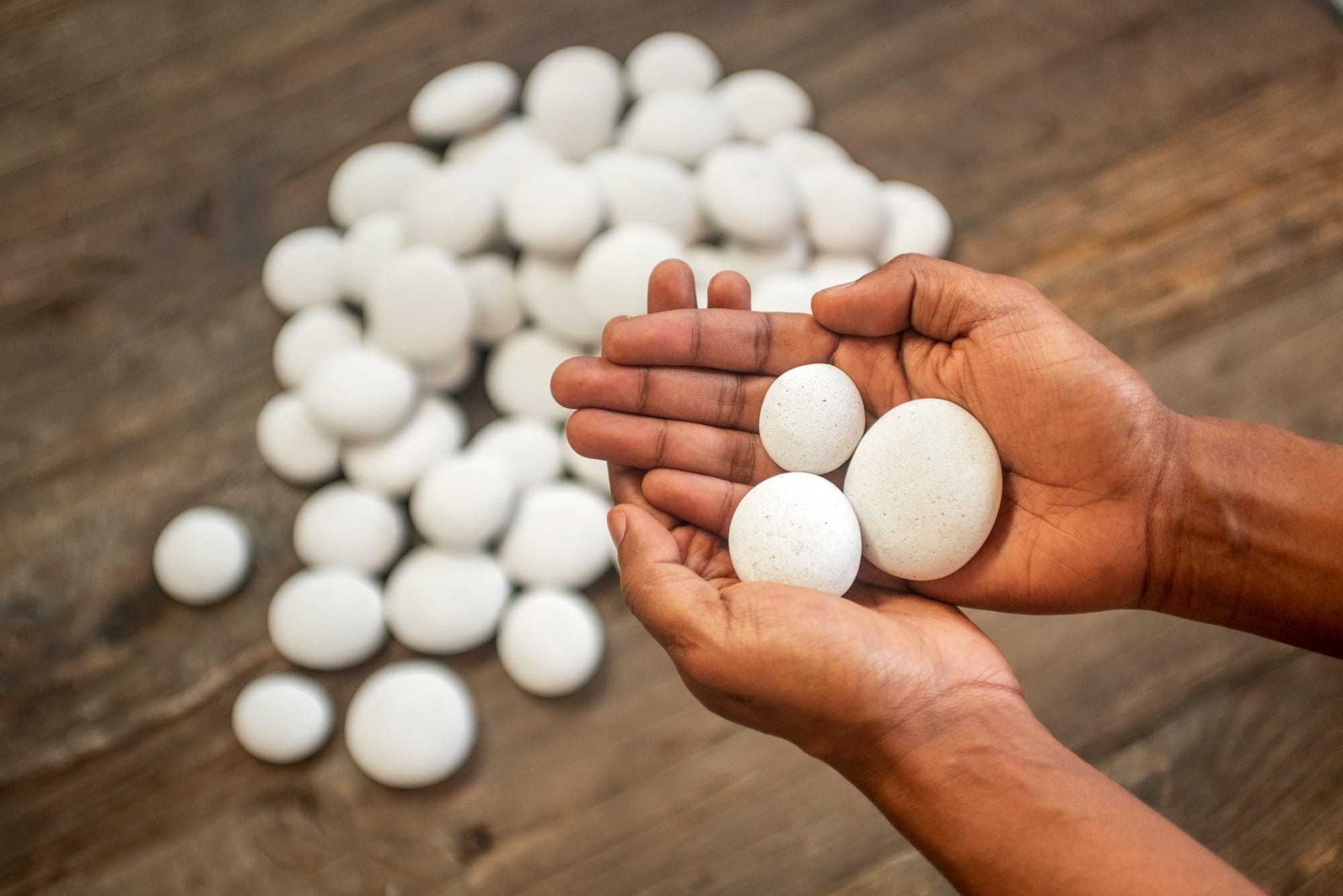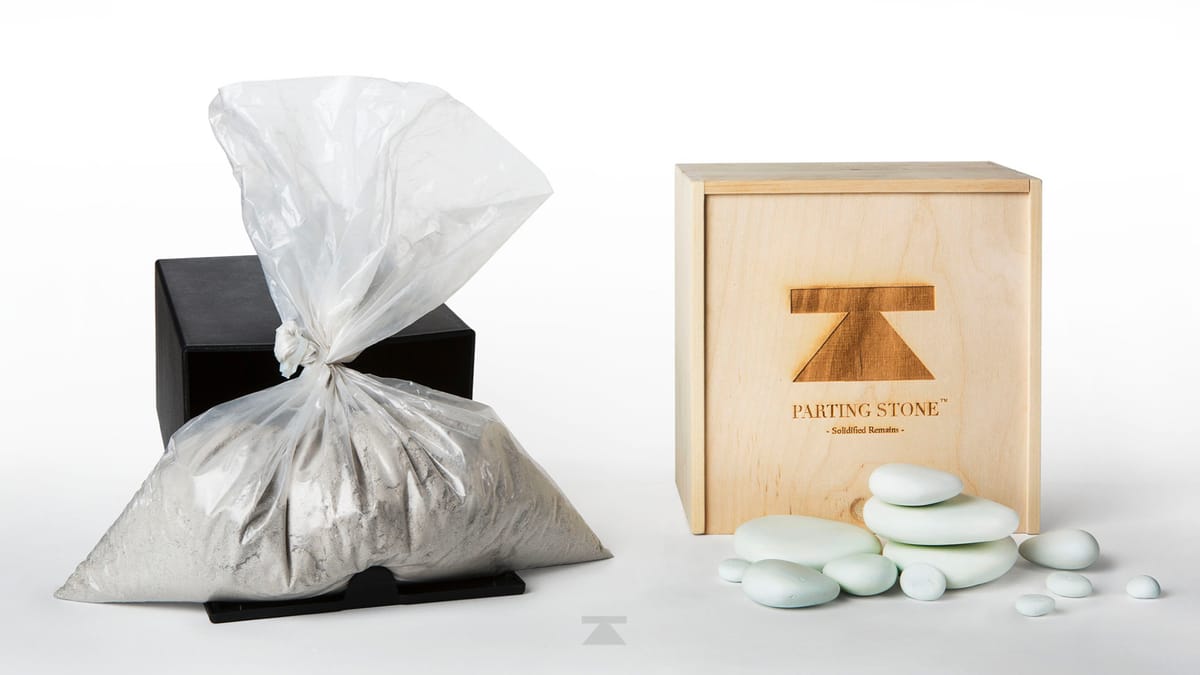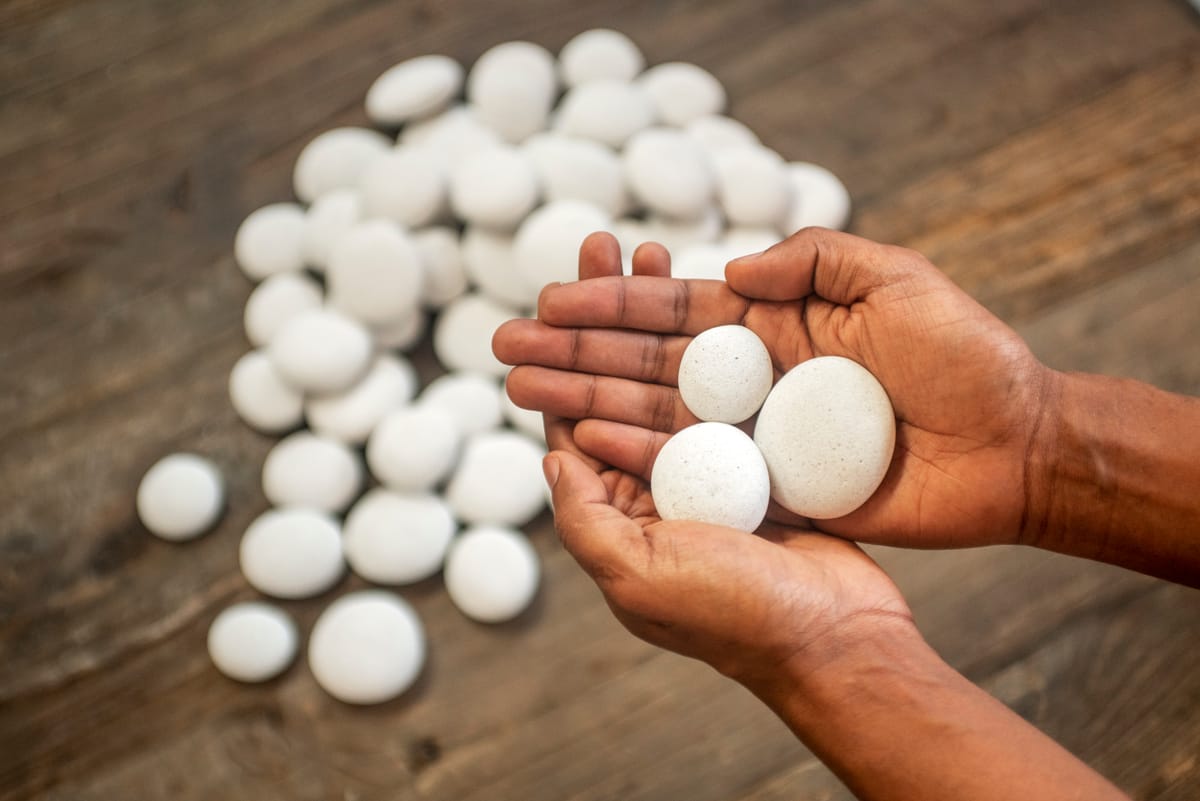What Are Cremation Stones?
Cremation stones are solidified remains created through a scientific process that transforms cremated ashes into smooth, touchable stone-like objects. The U.S. cremation rate reached 61.9% in 2024 (NFDA), creating demand for innovative memorial solutions beyond traditional urns. Parting Stone's proprietary solidification process, developed with Los Alamos National Laboratory, converts the full amount of cremated remains into 40-80+ individual stones that families can hold, share, and scatter comfortably.
Many families experience what grief counselors call "ash anxiety" - discomfort with the granular texture and unpredictable nature of conventional cremated remains. Traditional cremated remains often contain visible bone fragments, create spillage concerns, and generate emotional barriers to meaningful connection. Understanding whether it's safe to touch cremated ashes reveals common concerns families face with conventional remains. Cremation stones address these challenges by providing families with a clean, permanent form of remains that feels natural to touch and share among family members across different geographical locations.

A New Way to Hold Close What Matters Most
We transform cremated remains into beautiful, touchable stones that bring comfort when you need it. Something you can hold, share, and keep close.
Understanding the Solidification Process
Cremation stones result from a carefully controlled scientific transformation that begins after traditional cremation is complete. The science behind how ashes become stones involves specialized equipment and material science expertise to ensure successful conversion of each unique set of remains.
The first phase involves removing foreign materials like medical implants, staples, and metal components from the cremated remains. Technicians then refine the granular cremated remains into a fine powder using specialized grinding equipment. This refinement step ensures uniform consistency necessary for successful stone formation.

During the formation phase, a small amount of binder material is mixed with the refined cremated remains to create a clay-like substance. Individual stones are hand-formed from this mixture, with each stone's shape and size determined by the natural properties of the specific remains being processed. No artificial coloring or additives are introduced during this stage.
The final solidification occurs in high-temperature kilns that transform the formed clay-like material into ceramic-like stones. This heating process creates the hardness and permanence that allows cremation stones to withstand handling, travel, and environmental exposure. After cooling, each stone is polished to achieve a smooth, tactile surface suitable for holding and touching.
Parting Stone's solidification process ensures that families receive the full amount of their loved one's remains in a form that eliminates the anxiety and discomfort often associated with traditional cremated remains. The process typically takes 8-10 weeks to complete, prioritizing careful handling over speed.

What Makes Cremation Stones Different from Memorial Products?
Cremation stones represent a fundamental category distinction from memorial products like urns, jewelry, or keepsakes. Memorial products contain or display cremated remains, while cremation stones are the remains in a transformed state.
Traditional memorial solutions require families to interact with granular cremated remains that many find emotionally challenging. A survey of cremation families by the National Funeral Directors Association found that 73% of respondents stored cremated remains in closets or garages rather than displaying them prominently in their homes. This pattern suggests widespread discomfort with conventional cremated remains as a permanent memorial solution.
What to do with cremation ashes explores the limited options available with traditional cremated remains. Cremation stones eliminate this discomfort by fundamentally changing the physical properties of the remains themselves. The solidified remains feel like natural river stones, with ceramic-like durability that prevents dissolution in water or damage from normal handling. Families report feeling more comfortable displaying, touching, and interacting with cremation stones compared to traditional urns containing granular remains.
For instance, a family receiving cremation stones from Parting Stone can immediately touch and examine their loved one's remains without concern about spillage or bone fragments. Using Parting Stone's process, families receive 40-80+ individual stones that enable sharing among family members living in different states or countries.
Cremated remains can feel messy and meaningless. Instead of receiving a box of ashes following cremation, you can now receive a collection of stones. Solidified remains let you feel connection with the remains of your departed. Turn your ashes into stones at https://partingstone.com
Types of Cremation Available for Stone Transformation
Cremation stones can be created from remains produced through multiple disposition methods, expanding options for families with different preferences or restrictions.
Traditional flame cremation remains make up the majority of cremation stone requests. How cremation works explains the high-temperature cremation process that creates mineral compositions that respond well to solidification techniques. Flame cremation typically takes 2-3 hours at 1,400-1,800 degrees Fahrenheit, producing 3-9 pounds of cremated remains depending on body size and bone density.
Water cremation, also known as alkaline hydrolysis or aquamation, produces remains equally suitable for stone transformation. This process uses heated water and potassium hydroxide to dissolve soft tissues, leaving mineral bone remains similar to flame cremation. Water cremation operates at lower temperatures but produces comparable mineral content necessary for successful solidification.
Pet cremation remains also convert successfully into cremation stones, though the process requires different handling protocols due to size variations and potential medication residues. Understanding pet cremation costs helps families budget for both cremation and optional solidification services. Pet cremation stones typically number 15-40 depending on animal size, with smaller animals producing fewer but proportionally similar stones.
Consider a family who needs both human and pet cremation stones for a grandmother who passed away alongside her beloved dog. Parting Stone's dual-species capability provides families with compatible memorial stones that can be displayed together or distributed among family members who cared for both the human and pet.

Frequently Asked Questions About Cremation Stones
How many cremation stones does one person become?
The average person produces 40-80 cremation stones after solidification, depending on body size and bone density. A useful guideline is that one quart of cremated remains typically yields approximately one quart of cremation stones, though individual stones vary in size from thumbnail to palm-sized dimensions. The exact number cannot be predetermined because each person's bone composition creates unique formation characteristics.
What do cremation stones feel like to touch?
Cremation stones feel similar to natural river stones with smooth, polished surfaces that are comfortable to hold and touch. The solidified remains achieve ceramic-like hardness that won't scratch with fingernails or dissolve in water. Families report that the tactile experience feels natural and comforting rather than clinical or artificial.
Can cremation stones be scattered like regular ashes?
Yes, cremation stones are ideal for scattering ceremonies without the mess or unpredictability of conventional cremated remains. The stones won't blow in wind or create dust clouds during scattering events. Eco-friendly memorial options explains how cremation stones have negligible impact on soil chemistry compared to traditional cremated remains, making them environmentally suitable for outdoor memorial activities.
How much do cremation stones cost?
Cremation stone services typically cost $2,495 for human remains and $1,195 for pet remains. This pricing reflects the specialized laboratory equipment, skilled technicians, and 8-10 week processing time required for successful solidification. Memorial costs 2025 guide compares cremation stone pricing to other memorial options available to families.
What colors do cremation stones produce?
Cremation stone colors vary naturally based on each person's unique bone mineral composition. Most cremation stones appear white or off-white, while some develop blue, green, or gray hues during the solidification process. Occasional sets produce more dramatic color variations including earth tones or multicolored patterns. No artificial coloring is added - all colors result from natural mineral properties.
Can I get cremation stones from old ashes I already have?
Families can request cremation stone services for existing cremated remains stored at home. Parting Stone's collection kit system enables safe shipping of existing cremated remains to the laboratory facility using specialized containers and tracking protocols. The process works equally well for recently created or decades-old cremated remains.
What if I don't like my cremation stones?
Reputable cremation stone providers offer return-to-ash guarantees for families who are not satisfied with their solidified remains. The cremation stones can be reprocessed back into ash-like powder and returned to the family. This guarantee acknowledges that cremation stones represent a new category that some families may find unfamiliar.
Are cremation stones environmentally safe?
Cremation stones create less environmental impact than traditional cremated remains when scattered in natural settings. The solidified remains don't alter soil chemistry or water pH levels like conventional cremated remains can. The stones biodegrade slowly over geological time scales, similar to natural stone materials found in outdoor environments.
Who offers cremation stone services?
Cremation stone services are available through partnering funeral homes in all 50 states, with over 600 locations currently offering the option to families. Using Parting Stone's partner network, families can discuss cremation stones during funeral planning or request services independently for existing cremated remains through direct online ordering.
The Science Behind Successful Solidification
Cremation stone creation relies on material science principles that control crystal formation and ceramic hardness during high-temperature processing. Understanding these scientific foundations helps families appreciate the precision required for consistent results.
Bone mineral composition determines solidification success rates. Human bones contain approximately 65% mineral content (primarily calcium phosphate) and 35% organic material. During cremation, organic materials burn away while minerals remain in crystalline form. These minerals provide the foundation material necessary for stone formation.
Temperature control throughout the kiln process prevents cracking and ensures uniform hardness across all stones in each batch. Kiln temperatures must be precisely maintained within narrow ranges to avoid thermal shock that could fracture forming stones. Professional kilns used for cremation stones operate at different temperature profiles than pottery kilns, reflecting the unique properties of cremated remains.
Quality control measures include test sampling and batch monitoring to ensure successful transformation before final processing. Laboratory technicians assess each set of remains for medical implant residues, unusual material compositions, or other factors that might affect solidification outcomes. This assessment determines specific processing protocols needed for optimal results.
For instance, families working with Parting Stone benefit from proprietary protocols validated by Los Alamos National Laboratory scientists who specialize in ceramic and material science applications. Using Parting Stone's scientific approach, families receive cremation stones with consistent quality and appearance that reflects careful attention to material science principles.
Comparing Cremation Stones to Traditional Memorial Options
Cremation stones offer distinct advantages over conventional memorial products in terms of family interaction, sharing capabilities, and emotional comfort levels. Memorial decision readiness helps families evaluate different options during emotionally challenging times.
Traditional urns create a single memorial object that typically remains with one family member or in one location. This centralization can create family conflicts when multiple relatives want access to remains for memorial activities or personal comfort. Cremation stones enable natural division among family members without the ceremonial or emotional challenges of dividing cremated remains from an urn.
Memorial personalization options typically incorporate small amounts of cremated remains into pendants, rings, or other wearable items. While meaningful, these products contain only trace amounts of remains rather than representing the complete person or pet. Cremation stones provide the full amount of remains in shareable form while maintaining individual stone integrity.
Consider a grandmother whose five grandchildren live in different states who each want a personal connection to their grandmother's remains. Parting Stone's cremation stones provides each grandchild with actual stones from their grandmother rather than symbolic representations, enabling personal memorial rituals, travel companions, or bedside comfort items.
Cremation ashes vs cremation stones comparison reveals how scattering ceremonies benefit from cremation stones' controlled distribution compared to the unpredictable nature of ash scattering. Wind conditions, terrain, and weather can interfere with traditional scattering events, sometimes creating uncomfortable experiences for grieving families. Cremation stones allow families to place each stone individually in meaningful locations without concerns about wind dispersal or cleanup.
Memorial Applications for Cremation Stones
Cremation stones enable creative memorial approaches that traditional cremated remains cannot accommodate due to their granular texture and handling challenges. These applications help families maintain ongoing connections with deceased loved ones through tactile and visual interaction.
Garden memorials benefit from cremation stones' weather resistance and natural appearance. Unlike conventional cremated remains that can alter soil chemistry, cremation stones integrate into landscaping without environmental concerns. Families create dedicated memorial gardens where cremation stones serve as permanent markers while supporting plant growth and seasonal changes.
Travel companions represent one of the most meaningful applications for cremation stones. Individual stones travel easily in pockets, purses, or luggage without the logistical challenges of transporting urns through security checkpoints. Families report taking cremation stones on vacation trips, business travel, and significant life events where they want their loved one's presence.
Parting Stone customers achieve meaningful connections through daily interaction with cremation stones that traditional urns cannot provide. The stones serve as "worry beads" during stressful moments, pocket companions during important events, and bedside comfort items that feel natural to hold during grief processing.
Memorial options after death guide explores how memory sharing ceremonies allow families to distribute cremation stones in personalized ways that reflect individual relationships with the deceased. Rather than formal ash scattering events, families can organize informal gatherings where each person selects stones that "speak to them" and shares memories while handling the remains. These ceremonies often feel more comfortable and interactive than traditional memorial services.





